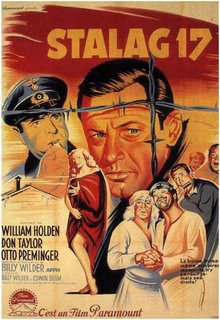Stalag 17

The granddaddy of all POW pictures, Stalag 17 (1953) is that rare oddity: a classic and a "cult" picture. Blending comedy with serious subject matter and tense drama, it can easily be recommended to anyone who enjoys mystery, intrigue and solid character work.
“Stalag” refers to one of the German POW camps in which American, British and Russians were housed during World War II, number 17b being primarily American. Unlike the grim concentration and death camps, stalag prisoners were covered by the Geneva Convention, under which enemy soldiers were to be fed and not abused, nor were they eligible for slave labour. Thus, you get a large number of young men who, although deprived and living in uncertain conditions, spent years without news of the outside world and without productive activity, and clustered in crowded conditions with strangers and without clear leaders.
This movie is Billy Wilder’s take on a popular Broadway play written by two survivors of Stalag 17. Wilder, a former refugee from Nazi Germany, lost both of his parents to the concentration camps, so his hatred for the German fascists is articulate and immense. However, he, like the authors of the play, realized that the situation was also filled with strong characters and gallows humour. It is this expert co-operation of menace and humour that makes Stalag 17 a unique picture.
The plot focuses on a particularly tense Christmas, during which, after a failed escape plan, the men begin to realize that there is a Nazi spy amongst them. Naturally, they assume the guilt of J.J. Sefton (Oscar winner William Holden), an unlikable and wily inmate who has no friends, only customers. As the plot unravels, the guilt and appearance of guilt shifts and sways, and the tension mounts as the comedy melts away.
This is a film I have enjoyed over and over, and look forward to seeing many, many more times. In fact, this movie has made my Top 100 films of all time, and it is unlikely it will be toppled.
However, Stalag 17 may not be to all tastes. The overt (and sometimes dated) comedy may upset some people who are sensitive about the sanctity of the subject matter. In the end, though, the comedy works within the confines of an American POW camp, and the monotony of life there makes one picture the hijinks we and the people we know might have gotten up to under such conditions. Further, the comedy is always underscored with the horrors of war and the constant threat faced by POWs in Europe.
It would be a mistake to tie this film in with the less reputable Hogan’s Heroes TV sitcom of a similar setting. The TV show was not, as common lore would tell you, based on this film, and the artistic accomplishments of the two are as different as Monet is from “The Garbage Pail Kids” trading cards.
Stalag 17 was released on DVD in a “Special Collector’s Edition” last March, and includes a “behind the scenes” featurette, and a documentary on the memories and experiences of Stalag 17’s real survivors. The audio commentary leaves much to be desired (which is understandable as the participants are all in their 80s, and the film was made over fifty years ago), but the transfer is as crisp and sharp as any I have seen.
All in all, its exciting performances, amusing and snappy script, and its ability to inspire tension beyond the initial viewing all make Stalag 17 a truly must-see picture.

1 Comments:
On a non-professional note, may I say, "Oh, William Holden!" (*swoon*)
Get that out of my system.
Post a Comment
<< Home